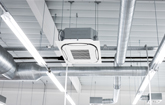Honeywell Hotel Study Suggests Air Purifiers Help Reduce Exposure To Airborne Contaminants
Computer modeling used to simulate air flow and movement of particulates in hotel common areas; demonstrates that filtration can potentially improve air quality and guests' confidence in hotel stays
ATLANTA, May 26, 2021 /PRNewswire/ -- The hotel industry was among the hardest hit by the pandemic. As travel rates increase, hotels are turning to science and technology to create environments that make guests feel safer. Honeywell (Nasdaq: HON), a leader in connected buildings, today released findings of a computer modeling study that examined indoor air quality in hotel common areas, focusing specifically on filtration and purification methods used to help mitigate potential airborne contaminants. The study found that mobile HEPA air purifiers can help reduce airborne contaminants by capturing particles as small as 0.3 microns and even smaller. In addition, placing purifiers in high-traffic areas is an important factor in reducing contaminants.
Examining Air Flow and Particulates Inside a Lobby
The model simulated airborne transmission inside a common area of a select-service hotel, conditioned by a traditional HVAC system, to see how far aerosols travel and how long they remain suspended in the air. Using computer models, the study measured airborne particulates of simulated talking, sneezing and coughing in a common area of a hotel property, such as the dining area, and the HVAC system's filtration efficiency to capture contaminants throughout the space.
The simulation observed the flow of large and small particles,1 taking into account factors such as the location of the HVAC supply and return air vents, air flow physics, and the social distancing of guests. In the model, some of the guests were wearing face coverings and some were not (i.e., to simulate eating in the dining area). The study specifically examined the impact of adding mobile air purifiers to help pull contaminated air away from guests.
Key Study Findings: Air Flow and Impact of Air Purifiers
- In the study, 97% of small particles were captured by air purifiers, which made a significant impact on the improvement of air quality.
- Talking created smaller and fewer droplets than a sneeze; yet, when the droplet attaches itself to a particle as an aerosol, dissemination continued as long as a person talked and traveled approximately 60 feet in the simulation due to HVAC air flow.
- The closer a source of contaminants is to the air purifier, the higher the purifier's effectiveness; mobile HEPA air purifiers captured particles as small as 0.3 microns (and smaller).
Key Study Findings: Effective Placement of Air Purifiers
- Return air vents are often at the edges of a space and, as a result, can allow aerosols and other particles to travel farther. Typically, HVAC systems in hotels and other commercial buildings are not placed to control contaminants; they are designed for comfort and energy efficiency by controlling temperature and humidity.
- Mobile HEPA air purifiers placed in strategic locations in a hotel lobby can be effective in managing the spread of contaminants, large and small.
- Air purifiers that are less obstructed and set at tabletop level were more effective.
"People are paying attention to indoor air quality, especially as they return to public places, and they want to know that their favorite destinations are taking precautions," said Manish Sharma, vice president, chief technology and chief product officer for Honeywell Building Technologies. "While this computer simulation looked at how hotels can improve the air quality in places where people congregate – like lobbies or dining areas – the learnings can be applied to other environments like schools, dorms and office conference rooms. Modeling suggests that placing portable air purifiers in the exact places that people are can effectively and quickly filter the air in a space before particles and aerosols disseminate. This study also demonstrates that improving air quality doesn't have to be costly or complicated -- a good filtration technology and intentional placement of it can help remove contaminants from traveling through the air."
Background on Air Purifiers
Standalone, mobile HEPA air purifiers are known to capture particles as small as 0.3 microns and can help reduce the spread of pathogens, viruses and contaminated air.2 NASA research suggests portable air purifiers can be effective at removing submicron and nonparticulate size matter as well.3 Air purifiers work by pulling stale air into the unit where a carbon filter captures larger particles, VOCs and odors. The air then passes through the HEPA filter, made of tightly woven glass or synthetic fibers to capture smaller particles including smoke, dust, pollen, mold spores, viruses and bacteria. Honeywell HEPA air purifiers offer building owners a cost-effective, plug-and-play solution that does not require infrastructural changes.
Honeywell's Healthy Buildings solutions are part of a comprehensive effort to innovate solutions that help critical sectors of the global economy recover, like hospitality, without the need to replace existing infrastructure. Honeywell's Healthy Buildings solutions provide a holistic view of a building's health based on key factors such as indoor air quality, occupant flow, PPE analytics, thermal screening, temperature monitoring, social distancing and sanitation efficacy.
About Honeywell Building Technologies
Honeywell Building Technologies (HBT) is transforming the way every building operates to help improve the quality of life. We are a leading building controls company with operations in more than 75 countries supported by a global channel partner network. Commercial building owners and operators use our hardware, software and analytics to help create safe, efficient and productive facilities. Our solutions and services are used in more than 10 million buildings worldwide.
Honeywell (www.honeywell.com) is a Fortune 100 technology company that delivers industry specific solutions that include aerospace products and services; control technologies for buildings and industry; and performance materials globally. Our technologies help aircraft, buildings, manufacturing plants, supply chains, and workers become more connected to make our world smarter, safer, and more sustainable. For more news and information on Honeywell, please visit www.honeywell.com/newsroom.
1 Simulation particle size distribution studied small particles (10 microns or smaller), medium particles (10 – 100 microns) and large particles (100+ microns).
2 Based on 3rd party independent CADR testing for the smoke CADR value when operated at the highest level. Air circulation depends on many factors, such as room size and configuration. There is no guarantee that all of the air in a room will pass through the filter.
3 NASA, Submicron and Nanoparticulate Matter Removal by HEPA-Rated Media Filters and Packed Beds of Granular Materials, J.L. Perry, J.H. Agui, R. Vijayakumar, May 2016
Megan McGovern |
Meagan Meldrim |
Honeywell |
Finn Partners |
(404) 216-6186 |
(616) 970-2177 |
SOURCE Honeywell

Related Links
WANT YOUR COMPANY'S NEWS FEATURED ON PRNEWSWIRE.COM?
Newsrooms &
Influencers
Digital Media
Outlets
Journalists
Opted In






Share this article